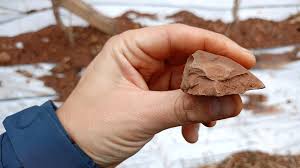Stone tools unearthed in southwest China helped a mysterious group eke out a living in a cold and harsh environment 60,000 to 50,000 years ago.
But whose hands shaped them? The answer could shake up what’s known about human origins during this period of the Stone Age, according to new research.
Archaeologists excavating the Longtan site in Yunnan province, on the southwestern edge of the Tibetan Plateau, uncovered hundreds of stone artifacts from two trenches dug into the region’s reddish, silty clay.
The research team determined many of the tools were crafted in the style known as Quina, which is typically regarded as an archaeological signature of Neanderthals, a species of ancient human. The style, or complex, hasn’t been found in East Asia before, the study published Monday in the journal Proceedings of the National Academy of Sciences said.
“The discovery at the Longtan site is remarkable, as it documents this particular tradition far (at least 7,000 or 8,000 kilometers) from the region traditionally associated with this techno-cultural complex,” study coauthor Davide Delpiano, a postdoctoral fellow in Paleolithic archaeology at the University of Ferrara in Italy, said via email.
Neanderthals roamed Eurasia for some 400,000 years before disappearing 40,000 years ago, but there is no evidence of their remains east of the Altai Mountains in southern Siberia.
Neanderthal bones and skeletons have previously been found alongside Quina stone tools at several sites in Western Europe including at the namesake site of La Quina in southwest France. Quina is one of a number of stone tool styles associated with Neanderthals that archaeologists call Mousterian culture.
The unprecedented discovery at Longtan had “significant implications,” Delpiano said, raising two competing possibilities. Neanderthals could have migrated east and reached what’s now China, or a different species of ancient human possibly made stone tools uncannily similar to those being made in Europe during this period known as the Middle Paleolithic.
Stone tools with far-reaching implications
The tool set unearthed at Longtan in 2019 and 2020 include scrapers, used to work hides or wood with one sharp side, stone points that might have been attached to wooden spears, and tools that had notches a bit like a saw.
In Europe, Neanderthals used Quina stone tools during a dry and cold period 60,000 to 50,000 years ago in a landscape of open woodland. The tools would have helped Neanderthals hunt migrating herds of reindeer, giant deer, horses and bison, according to the study.
Quina tools typically had a long period of use and were often retouched and recycled — suggesting they were a response to patchy resources and a highly mobile lifestyle, the researchers wrote.
Analysis of ancient pollen grains from Longtan revealed the climate and environment would have been similar in southwestern China to that of Europe. However, the authors found no animal remains at the site, so it’s not known whether the humans who lived there hunted similar animals, they said.












